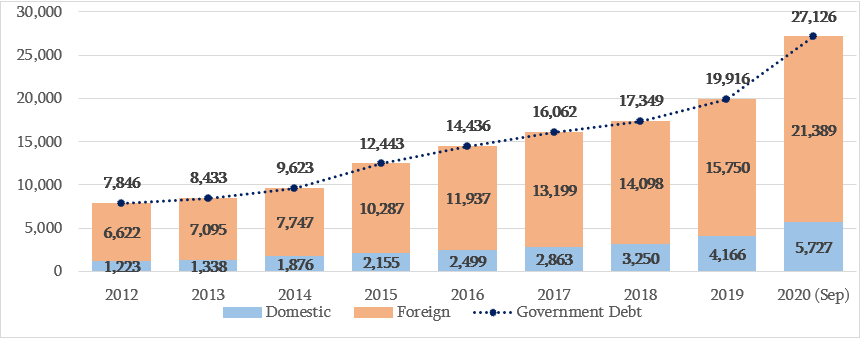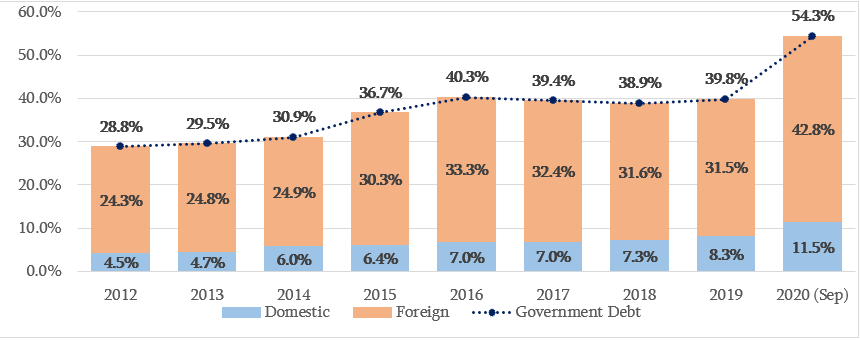Resume: Amid the ongoing pandemic and the ensuing economic crisis, issues related to the growth of government debt have been under particular public scrutiny. According to 2020’s current data, the total government debt constitutes nearly GEL 27.1 billion which amounts to 54.3% of the estimated GDP. In accordance with the Organic Law of Georgia on Economic Freedom, the government debt to the GDP ratio should not exceed 60%. Naturally, debt growth is not something to be desired and both the public and the opposition have entirely legitimate concerns. However, some politicians falsely claim that the debt to the GDP ratio exceeded the legally determined threshold. In fact, the debt to the GDP ratio has not reached the 60% threshold and is not expected to do so in the future based on current data. However, it is unclear how the events will unfold and how the authorities’ expectations will be vindicated. At the same time, the pandemic-induced declaration of the state of emergency will allow the government to keep the debt and the deficit figures above the legal threshold for three years.
The budget deficit is of no less importance than the debt. Apart from the allocation of expenses needed to fight the pandemic, deficit spending also stimulates demand which decreased as a result of the pandemic. However, this also has ensuing negative consequences such as, for instance: inflation, drops in savings, hiking interest rates, etc. In other words, the negative results associated with the impact of the current deficit as well as with foreign debt growth will reverberate in the upcoming years. The threshold of the Freedom Act’s second macroeconomic parameter is about the common budget deficit. In particular, the consolidated budget deficit should not exceed 3% of the GDP. The estimated deficit of 2020’s common budget constitutes 8.3% which is 5.7 percentage points more as compared to the previous year and exceeds the legally allowed 3%. According to the plan of the Ministry of Finance and respective legislation, the deficit figure will set down to 3% by 2023.
Analysis
In the past years, the government debt has constantly been a matter of public scrutiny and the interest further increased amid the novel coronavirus pandemic. One of the standard mechanisms to respond to the economic crisis, routinely employed by almost any country around the world, is to stimulate the economy by budgetary resources and counterbalance the rising social problems. The fiscal part of the government response affects a country’s budget in two ways: on the one hand, budget expenses for social assistance and economic stimulation increase whilst, on the other hand, economic activity plunges and, therefore, the budget receives less tax revenues as compared to the planned amount. As a result, the sharp growth of debt, which was increasing even prior to the pandemic, has been brought to the forefront of the agenda.
Government debt comprises domestic debt and foreign debt. According to 2020’s data, the total government debt amounts to nearly GEL 27.1 billion whereas domestic debt is GEL 5.7 billion and foreign debt is GEL 21.3 billion. Of note is that the absolute figure of the total debt increased by GEL 7.2 billion as compared to 2019. Of that amount, domestic debt increased by GEL 1.5 billion and foreign debt increased by GEL 5.6 billion.
Graph 1: Government Debt Statistics in 2012-2020 (GEL Million)

Source: Ministry of Finance of Georgia
Since a specific figure can be huge when it comes to a smaller economy and tiny when it comes to a larger economy, the common indicator used to duly measure the debt burden is the debt to the GDP ratio which is shown in Graph 2. The current debt to GDP ratio is 54.3% whilst the domestic debt to the GDP ratio is 11.5% and the foreign debt to the GDP ratio is 42.8%. In accordance with 2019’s data, the government debt to the GDP ratio constituted 39.8%.
Of important note is that the Law of Georgia on Economic Freedom determines the thresholds of the macroeconomic parameters to ensure constitutional safeguards of economic rights and freedoms. The aim of fiscal rules, as prescribed by this law, is to cap the growth of the government’s budget spending’s relative figures. The law sets the following thresholds: the consolidated budget deficit [1] to the GDP ratio should not exceed 3% and the government debt to the GDP ratio should not exceed 60%. Budget planning or/and executing the planned parameters beyond the thresholds set by this law is possible by Georgian legislation in the case of a declaration of martial law or a state of emergency and if there is a need to fund measures to liquidate those consequences which arose as a result of the declaration of martial law/state of emergency. At the same time, the Government of Georgia has to submit a plan to the Parliament of Georgia to restore the legally prescribed parameters. The plan for returning back to the legally prescribed parameters should not exceed three years.
Naturally, debt growth is not something to be desired and both the public and the opposition have entirely legitimate concerns. However, some politicians falsely claim that the debt to the GDP ratio exceeded the legally determined threshold. In fact, the debt to the GDP ratio has not reached the 60% threshold and is not expected to do so in the future based on current data. In particular, according to the data of the Ministry of Finance, it planned to keep the debt to the GDP ratio at 55.9% and decrease it to 55.4% in 2023. It is unclear how the events will unfold and what the economic/social conjecture will look like in the future.
However, it is also unclear how the events will unfold and how the authorities’ expectations will be vindicated. At the same time, the pandemic-induced declaration of the state of emergency will allow the government to have the debt and the deficit figures above the legal threshold for three years. The sharp growth in foreign debt is largely associated with the GEL depreciation which causes the volume of the payable debt to increase. Although foreign debt may increase in a lesser proportion, it is possible that the government debt to the GDP ratio will exceed 60% notwithstanding the government-planned dynamic in the case of a continued GEL depreciation or if the need arises to add more debt in the future.
Graph 2: Government Debt to GDP Ratio in 2012-2020

Source: Ministry of Finance of Georgia, author’s calculations
The budget deficit is of no less importance than the debt. The difference between budget revenues and expenses is the budget’s operational balance whilst the difference between the budget’s operational balance and the change in non-financial assets (privatisation, selling property) is the total budget balance. A positive total balance means a budget surplus whilst a negative total balance means a budget deficit. A budget deficit means that the budget has less revenues than expenses and the government has to take a debt in order to finance the difference. Apart from the allocation of expenses needed to fight the pandemic, deficit spending also stimulates demand which decreased as a result of the pandemic. However, it is natural that this also has ensuing negative consequences such as, for instance: inflation, drops in savings, hiking interest rates, etc. In other words, the negative results associated with the impact of the current deficit as well as with the growth of the foreign debt will reverberate in the upcoming years. The threshold of the Freedom Act’s second macroeconomic parameter is about the common budget deficit. In particular, the consolidated budget deficit should not exceed 3% of the GDP, meaning that the aim of legislative commitments is to ensure that the government’s planned expenses do not substantially exceed the planned revenues.
Table 1: Consolidated Budget Deficit in 2017-2020 (GEL Million, Estimate)

Source: Ministry of Finance of Georgia
The estimated deficit of 2020’s consolidated budget constitutes 8.3% which is 5.7 percentage points more as compared to the previous year and exceeds the legally allowed 3%. According to the plan of the Ministry of Finance and the respective legislation, the deficit figure will set down to 3% by 2023.







